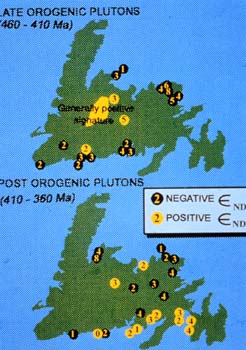|
|
|
 |
| media > slideset
> tools and methods
> |
| |
 |

An example from Newfoundland. Isotopic results
from late orogenic and post-orogenic, granitoid plutons. The yellow
dots show where plutons were derived from the mantle (i.e. very
deep). The black dots show where plutons were formed by melting
of crustal (deep) and supra-crustal (shallow) rockss. |
Under favourable circumstances, the age of the
deep crust may be determined. All this is particularly important
in regions of complex geology where the upper and lower parts of
the crust may have evolved independently and been structurally juxtaposed.
Many other isotope systems and other geochronologic methods (e.g.
"fission track" dating) provide critical chronological
data.
Important economic applications of geochronology and radiogenic
isotopes relate to the determination of the emplacement times of
ore deposits and determination of the sources of their chemical
components.
|
| previous page |
next image |
|
